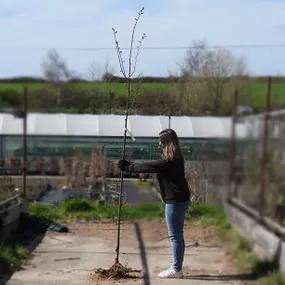Sargents Japanese Cherry Blossom Trees
Honest Delivery Prices- Large, spreading tree.
- Red-bronze young leaves.
- Superb autumn colour.
- Pink blossom.
- RHS Award of Garden Merit
- Max. Height: 19m
Recommended extras
Description
Prunus sargentii: Bareroot Sargent's Cherry Trees in Standard Sizes
Prunus sargentii is a medium sized, spreading cherry blossom tree with pink flowers and red-purple young leaves. It has delicate, small pink flowers that appear at the same time as the young leaves, which are a rich purple-red colour. The leaves are magnificent in autumn, looking like cooling lava for about a week and then going out in a fireball of crimson. The blossom is sometimes followed by black (safe but inedible) cherries which are loved by birds and squirrels. The bark is a smooth, reddish brown. Although mature trees will take up a bit of space, they only cast light shade.
Quite upright when it is young, it matures into a wide, rounded form, up to 8m tall.
Browse our other varieties of Cherry Blossom trees, including the extra narrow form of this tree, Prunus sargentii Rancho.
Delivery season: Sargent's Cherry trees are delivered bareroot during late autumn and winter, approximately November-March inclusive.
Choosing a size: Small trees are cheaper, easier to handle and more forgiving of less than ideal aftercare, so they are best for a big planting project. If instant impact is your priority, or if you are only buying a few plants for use in a place where it is convenient to water them well in their first year, then you may as well use bigger ones. All our bareroot trees are measured by their height in centimetres above the ground (the roots aren't measured).
Features:
- Height: To 8m
- Soil: Any decently well drained
- Use: Specimen, avenues, urban
- Colour: Pink flowers in April
- RHS Award of Garden Merit
- Bareroot delivery only: November-March
Growing Prunus sargentii
Suitable for any well drained soil, we recommend planting in full sun.
Planting Instructions
Notes on planting Prunus sargentii trees:
Prunus sargentii trees prefer fertile, moist soil with good drainage. They like heavy clay, as long as the site doesn't become waterlogged in winter. They are good to grow on chalky soil.
Although they are tolerant of shade, we really recommend them for full sun. Cherry trees in the shade tend to become spindly and won't flower very well.
We don't recommend them for exposed, windy sites, where they will be blown out of shape by the wind.
Although your trees are hardy, late spring frosts can ruin their flower display. Avoid planting cherry blossom trees in frost pockets or North facing sites in colder areas.
Prepare your site before planting:
It is good to dig over the site where you plant a tree several months in advance. Kill the weeds first: for tough weeds like nettles, brambles and ground elder, you will usually need a weed-killer to get rid of them. When you dig the soil over, remove stones and other rubbish and mix in well rotted compost or manure down to the depth of about 2 spades.
Watch our video on how to plant a tree for full instructions.
Remember to water establishing trees during dry weather for at least a year after planting.
Tree Planting accessories:
Prepare your site for planting by killing the weeds and grass.
You can buy a tree planting pack with a wooden stake & rubber tie to support the tree and a mulch mat with pegs to protect the soil around the base of your tree from weeds and drying out.
We suggest that you use mycorrhizal "friendly fungi" on the roots of all newly planted large trees: if your soil quality is poor, we strongly recommend it.
You can also improve your soil with bonemeal organic fertiliser.
Did You Know?
Native to Japan and Korea, it quickly became popular after it was introduced in 1908. It is named after Charles Sprague Sargent (1841-1927), who was a Director of the Arnold Arboretum in Massachusetts (it was brought to the USA before the UK).
Standard trees are measured by their girth in centimetres 1 metre above ground level: their trunk's waist measurement. Unlike sapling trees and hedge plants, standards aren't measured by their height, which will vary quite a bit both between and within species.
So, a 6/8cm standard tree has a trunk with a circumference of 6-8cm and an 8/10 standard has a trunk 8-10cm around. This measurement makes no difference to the tree's final height.
On average, standard trees are 2-3.5 metres tall when they arrive, but we cannot tell you precisely how tall your trees will be before we deliver them.

 2.webp)
 2.webp)
 3.webp)
